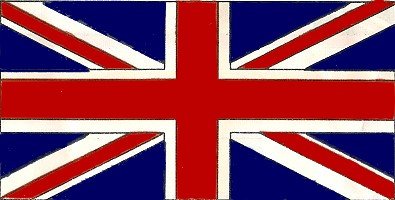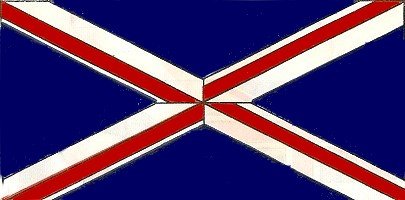- Search our Site
- Project Britain
- Calendars
- Facts and figures
- London
- Great Britain
- Union Flag
- A-Z of Britain
- Customs & traditions
- Britain today
- Daily Life
- Money
- Etiquette
- Monarchy
- Government
- Education
- Tourist Information
- Food and drink
- Sports and leisure
- History
- Kings and Queens
- Superstitions
- Glossary
|
The Making of the Union Flag
Northern Ireland – St Patrick |
|||||
|
Ireland is represented by
the cross of St. Patrick ———————————————— On 1 January 1801, Ireland was united with Great Britain and it became necessary to have a new National Flag in which Ireland was represented. The cross St Patrick was combined with the Union Flag of St George and St Andrew, to create the Union Flag that has been flown ever since.
The cross of St. Patrick was inserted so the position given to St. Andrew’s Cross in one quarter was the same as that given to the Irish one in the diagonally opposite quarter; in heraldry this is known as "counterchanging"
The ‘new’ British flag is not symmetrical because of the counterchange. As Scotland joined the Union nearly two hundred years before Ireland, St Andrew’s Cross was placed uppermost in the top quarter nearest the flagstaff, this being the most honourable position according to heraldry, while the Irish Cross was given the second most honourable position, the top quarter of the fly. In order to avoid having the red of the Irish Cross directly upon the blue field of the Scottish one an edging of the white field of the Irish Cross is used. The symbols of Scotland and Ireland are placed sided by side on the Union Flag.
NB. The St. Patrick’s Cross remains in the flag even though today only Northern Ireland is part of the United Kingdom. |
|||||
 © Copyright – please read © Copyright – please readAll the materials on these pages are free for homework and classroom use only. You may not redistribute, sell or place the content of this page on any other website or blog without written permission from the . |
© Copyright 2013
is the creator of the Woodlands Resources section of the Woodlands Junior website.
The two websites projectbritain.com and primaryhomeworkhelp.co.uk are the new homes for the Woodlands Resources.
left Woodlands in 2003 to work in Kent schools as an ICT Consulatant.
She now teaches computers at The Granville School and St. John’s Primary School in Sevenoaks Kent.
Woodlands Junior Homework Help new website




